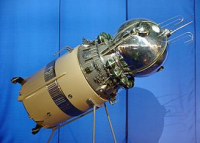








The Vostok programme was a Soviet human spaceflight project to put the first Soviet citizens into low Earth orbit and return them safely. Competing with the United States Project Mercury, it succeeded in placing the first human, Yuri Gagarin, into space, in a single orbit in Vostok 1 on April 12, 1961. The Vostok capsule was developed from the Zenit spy satellite project and adapted the Vostok launch rocket from the existing R-7 Semyorka intercontinental ballistic missile (ICBM) design. The name "Vostok" was treated as classified information until Gagarin's flight was first publicly disclosed to the world press.
Chief designer of the Soviet space program, Sergei Korolev, decided that the cosmonauts must be male, between 25 and 30 years old, no taller than 1.75 meters, and weigh no more than 72 kilograms.The final specifications for cosmonauts were approved in June 1959. By September interviews with potential cosmonauts had begun. Although the pilots were not told they might be flying into space, one of the physicians in charge of the selection process believed that some pilots had figured this out.Just over 200 candidates made it through the interview process, and by October a series of demanding physical tests were conducted on those remaining, such as exposure to low pressures, and a centrifuge test.By the end of 1959, 20 men had been selected. Korolev insisted on having a larger group than NASA's seven astronaut team.Of these 20, five were outside the desired age range; so the age requirement was relaxed. Unlike NASA's astronaut group, this group did not particularly consist of experienced pilots; Belyayev was the most experienced with 900 flying hours. The Soviet spacecraft were more automated than the American counterparts, so significant piloting experience was not necessary.
On January 11, 1960, Soviet Chief Marshal of Aviation Konstantin Vershinin approved plans to establish the Cosmonaut Training Center, whose exclusive purpose would be to prepare the cosmonauts for their upcoming flights; initially the facility would have about 250 staff. Vershinin assigned the already famous aviator Nikolai Kamanin to supervise operations at the facility. By March, most of the cosmonauts had arrived at the training facility; on March 7 Vershinin gave a welcome speech, and those who were present were formally inducted into the cosmonaut group.By mid-June all twenty were permanently stationed at the center. In March the cosmonauts were started on a daily fitness regime, and were taught classes on topics such as rocket space systems, navigation, geophysics, and astronomy.
Due to the initial facility's space limitations, the cosmonauts and staff were relocated to a new facility in Star City (then known as Zelenyy), which has been the home of Russia's cosmonaut training program for over fifty years. The move officially took place on June 29, 1960.